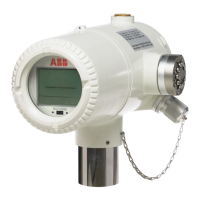124 | NGC8200 AND PGC1000 USER MANUAL | 2101510MNAH
To troubleshoot the carrier pressure regulator:
1. Verify the carrier gas cylinder pressure regulator is open. If not, open the regulator on the
carrier gas cylinder.
2. Verify the carrier gas cylinder pressure regulator set point is 90 PSIG. If not, correct the set
point to 90 PSIG (620.5 kPa or 6.2 bars).
3. Perform the column vent pressure test (see section 11.3.1) for both column vent 1 and column
vent 2. If either test failed, proceed to the next step.
4. Replace the analytical module.
11.1.2 Oven Temperature Test
This alarm is indicative of a temperature condition. The causes range from an unplugged cable to a
bad module heater.
To troubleshoot oven temperature:
1. Verify that the cable is plugged in and in good condition.
2. Verify that the analytical processor to GC module cable is plugged in and in good condition. If
the cable appears to be damaged, continue to the next step.
3. Replace the analytical module.
11.1.3 Processor Control Test
These alarms are indicative of inability to control a function. If the failure is for one or both of the
column carrier pressure tests, it could be a missing or failed gasket. If the failure is in the oven control
temperature test, it could be a missing GC module cover or analytical module thermal flask.
To troubleshoot processer control:
1. If the startup diagnostics are being performed following the disassembly or replacement of a
module or spare part, ensure that the device is completely reassembled, including the thermal
flask and both the front and rear end caps. Then re-start the diagnostics. If diagnostics again
fail, repeat disassembly steps and verify that all gaskets and connections are tight and correctly
installed.
2. If the startup diagnostics are being performed from an initial startup, verify that the analytical
module is not loose inside the enclosure.
3. Verify that the GC module is tight and that the cables are correctly installed and not damaged.
4. Reassemble the device and restart diagnostics. If the device continues to fail, replace the entire
analytical module and return to ABB for repair or replacement.
11.1.4 Stream Test
The stream flow diagnostics test the stream pressure at different conditions as listed below. Each
column will display the pressure results after that part of the test has completed. The status column
will reflect the current and final status of the tests.
IMPORTANT NOTE: During the stream test, streams with no gas pressure will fail and will be
disabled in the stream sequence. To enable these streams, click Stream Setup on the Analyzer
Operation screen.
The following table gives descriptive status and definitions for only the stream test and are in addition
to those defined for all startup diagnostics.
Table 11-3: Stream test diagnostics
Failed the Resting Pressure test
Failed No Pressure Failed the Maximum Pressure test
Failed Holding Pressure Failed the Holding Pressure test
Failed Flowing Pressure Failed the Flowing Pressure test
Failed the Ending Pressure test
displayed by streams waiting to be tested.
The tests are run sequentially.
These alarms are indicative of a sample pressure problem. The causes range from a plugged frit filter
to a bad GC module.

